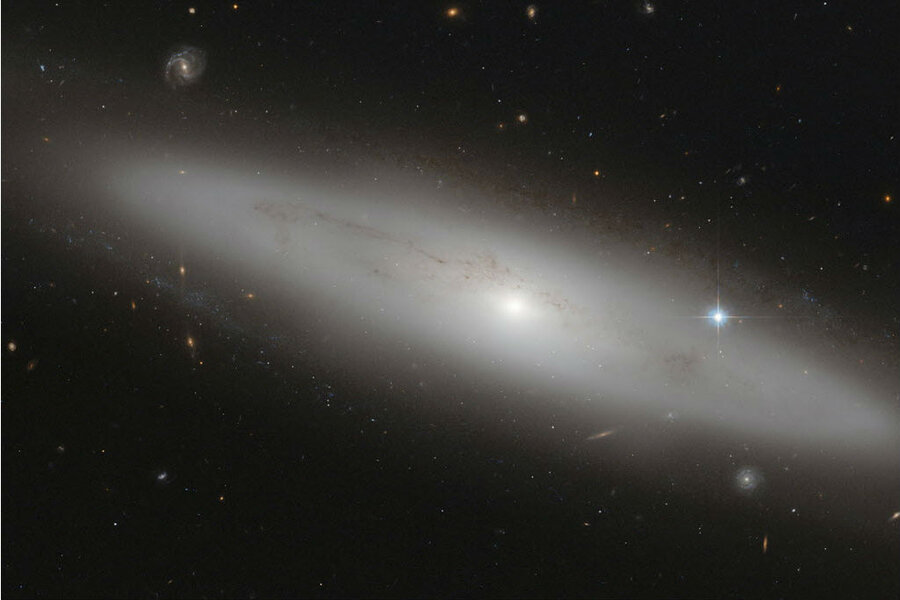Scientists pinpoint source of mysterious space signals. But what are they?
Loading...
One of the most mysterious phenomena in the observed universe is known as a "Fast Radio Burst," or FRB. These massive flashes of light are extremely powerful, and detectable from billions of lightyears away.
Despite the ferocity of the bursts, the detectable radio emissions are also extremely short-lived, making them difficult to find unless a radio telescope happens to be looking directly at the phenomenon. Because of this, the origin of an FRB is even harder to pinpoint.
But now, the unprecedented discovery of a repeating FRB has allowed a team of scientists to identify its origin, prompting researchers to reconsider what they thought they knew about FRBs.
The first FRB was discovered in 2007, in archived data from the Parkes radio telescope in New South Wales, Australia. Since then, only 18 FRBs have been detected directly, despite scientists estimating that 10,000 of the millisecond-long events flash across the sky every day.
"I don't exaggerate when I say there are more theories for what these could be than there are observed bursts," Shami Chatterjee, an astronomer at Cornell and the lead author of the new study, told the BBC.
FRB 121102, first discovered in 2012, is the subject of the new paper in the journal Nature and two supplemental papers in the Astrophysical Journal Letters. It is the first FRB known to repeat itself, allowing scientists to pin down its location: a dwarf galaxy over 3 billion light years away.
"The host galaxy for this FRB appears to be a very humble and unassuming dwarf galaxy, which is less than 1 percent of the mass of our Milky Way galaxy," McGill University postdoctoral researcher Shriharsh Tendulkar said in a statement.
"That's surprising," he explained. "One would generally expect most FRBs to come from large galaxies which have the largest numbers of stars and neutron stars – remnants of massive stars. This dwarf galaxy has fewer stars, but is forming stars at a high rate, which may suggest that FRBs are linked to young neutron stars. There are also two other classes of extreme events – long duration gamma-ray bursts and superluminous supernovae – that frequently occur in dwarf galaxies, as well. This discovery may hint at links between FRBs and those two kinds of events."
Before FRB 121102 was discovered, many theories for the origin of the phenomenon were predicated on the idea that FRBs originated from incredibly bright explosions.
"When we reported last year that one of these objects was repeating, that – in one go – knocked out about half of those models, because for this one source, at least, we knew it couldn't be explosive," Dr. Chatterje told the BBC. "It had to be something where the engine that produced this survived for the next flash."
Over the course of 83 hours of observation in six months with the Karl G. Jansky Very Large Array (VLA) in New Mexico, a collection of 27 radio telescopes, researchers spotted nine FRBs coming from the dwarf galaxy. In order to make sure the positioning was exact, researchers verified their results using telescopes from the European VLBI Network (EVN), the William E. Gordon Telescope of the Arecibo Observatory, and the National Science Foundation's Very Long Baseline Array (VLBA).
In addition to the FRBs, the radio telescopes detected a weaker, but continuous, radio emission from within 100 light years of the flashes.
"We think that the bursts and the continuous source are likely to be either the same object or that they are somehow physically associated with each other," said Benito Marcote, of the Joint Institute for VLBI ERIC, Dwingeloo, Netherlands, in a statement.
One possible culprit for the FRB is a type of highly magnetic neutron star known as a magnetar, which emits radio pulses in our own galaxy, but not at this strength. Alternatively, it could have something to do with the dwarf galaxy's central black hole.
"There is still a lot of work to do to unravel the mystery surrounding FRBs," said senior team member Victoria Kaspi. "But identifying the host galaxy for this repeating FRB marks a big step toward solving the puzzle."
Even if they determine what causes the repeating bursts of FRB 121102, the researchers warn, it may not resolve the mystery of other, single-burst FRBs.
But perhaps all FRBs repeat, and this is simply the first time we have captured proof, noted the scientists.
"There used to be an expression, 'as unchanging as the heavens,'" Chatterjee told National Geographic. "But the heavens are changing very fast. The sky is just boiling and seething with these incredibly powerful events that we don't really understand."








